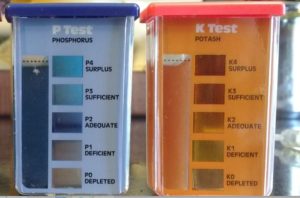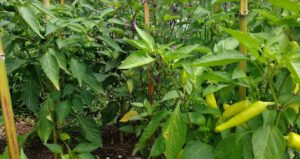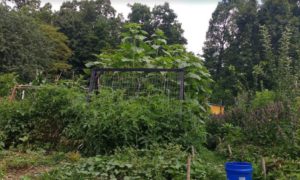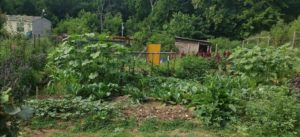Welcome to the Organic Growers’ Tool Kit Series
Tool #5: Mycorrhizael Inoculant
In our last two posts in the Organic Growers’ Tool Kit series, we took a look at the role of nitrogen, phosphorous, and potassium (N-P-K) in plant development, in our soils, and in relationship to organic matter. We also covered some sources of nitrogen that won’t derail your soil-building efforts and are safer for the environment.
Read the Other Articles in the Organic Growers’ Tool Kit Series Here
Now, we’re going to delve deeper into the challenges and solutions related to supplying your garden with phosphorous and potassium for good fruit set and overall plant health.
The Great Phosphorous Dilemma
Phosphorous may be an even more contentious amendment than nitrogen. It’s a necessary nutrient for plant growth. However, as runoff, it can it be environmentally devastating to waterways.
Like nitrogen, phosphorous is a primary contributor to toxic algae blooms. It is harmful to drinking water supplies through infiltration to groundwater. It can make people ill through contact in polluted waterways or through consumption of contaminated fish.1)https://www.epa.gov/nutrientpollution/problem
Depending on whom you ask, we may also be rapidly approaching “Peak Phosphorus.” This is the point at which it will no longer be economically reasonable to extract rock phosphate—the most common form of phosphorous—from the earth. Some estimates say that will occur as early as 2030.
Besides that, most of the rock phosphate is located in Syria, China, Morocco, and Algeria. Depending on different countries’ relationships with those providers and the state of those economies, the availability of phosphorous may peak even earlier.
As if all that doesn’t make it complicated enough, it’s also extremely easy to lock up phosphorous in your soil. Many longtime organic gardeners have plenty of phosphorous in their soil thanks to the addition of composted livestock manure. However, that phosphorous has become inorganic and is no longer available to plants.
The Problem With Potassium
Potassium (potash) is a necessary macronutrient for plant health. Except in salty soils, potassium tends to be plentiful in most areas. Also, if you are adding compost and other organic matter regularly, you most likely have sufficient potassium in your garden.
Organic gardens, particularly if you apply livestock manure regularly, often accumulate potassium at higher-than-necessary rates for good plant production. This excess potassium can bind with other agents in the soil, becoming inorganic (unavailable to plants).
Thankfully, too much potassium in your garden doesn’t pose the same environmental risks as nitrogen and phosphorous. However, an accumulation of inorganic potassium can cause your plants to take up less magnesium and calcium. And these are both also essential for good plant production.
To me, this is like the worst kind of catch-22. Here we are doing so much work to build our soil and grow healthy food. But, we run the risk of actually making our plants less healthy and our food less nutritious.
Luckily, there’s a way out of this potential trap!
Organic Growers’ Tool #5: Mycorrhizael Inoculant to the Rescue
There is a growing body of research that suggests that both phosphorous and potassium can be made bioavailable and more balanced in the soil if plant roots have the right mycorrhizael relationships.
Basically, these little fungi establish working relationships with plants. In exchange for sugars made by the plants, these fungi predigest and make accessible to plants nutrients such as forms of phosphorous and potassium that are not already water soluble.
In a perennial landscape, with lots of organic matter, these root-to-fungi relationships are often very well established. This is why forests, which tend to be nutrient deficient by our gardening standards, can support vast amounts of life.
How Mycorrhizae Help
Mycorrhizae make nutrients available on demand by extending the root system of plants into areas that the plant could not otherwise reach with its own roots. They are kind of like an extension cord, giving plants more room to access necessary energy.
In a garden loaded with organic matter (my #1 tool for organic growers), there is usually sufficient P and K to meet plants’ needs in the soil. However, it may simply not be accessible to plants in its present form.
In that case, rather than extending the root reach as in a forest, mycorrhizae are actually doing the equivalent of cooking up what’s there to make it palatable for plants.
In an annual garden with a high rate of plant turnover, though, it’s hard for the fungi that perform these services to transfer from plant to plant. No-till practices and keeping beds continuously planted can help.
To ensure that your plants have those beneficial mycorrhizael connections from day 1, using mycorrhizael inoculant at the time of planting is ideal. This can help solve both the phosphorous dilemma and the potassium problem.
Also, if you recall from tool #4—nitrogen fertilizers for organic gardens—I recommended that you apply 1/2 as much slow-release nitrogen as called for in your soil test. Well, that’s also because mycorrhizael inoculants make slow-release nitrogen available in compost and other sources.
Additionally, they enable plants to grow and be healthy even when they don’t have 100% of the nitrogen they need.
Choosing Mycorrhizael Inoculant
You can buy mycorrhizael inoculants designed for annual vegetable gardens from online and organic retailers. There are two primary kinds of inoculant available—Endo-mycorrhizae (also called arbuscular mycorrhizae) and Ecto-mycorrhizae.
For use in a vegetable garden, choose inoculants that contain primarily endo-mycorrhizae or arbuscular mycorrhizae. (Ecto-mycorrhizae are believed to be primarily useful for only certain plants such as orchids or woody perennials.)
Mycorrhizael inoculants are also offered with other amendments such as minerals and beneficial bacteria. These mixes are very useful. However, they are sometimes more expensive than if you buy pure endo-mycorrhizae and purchase other nutrients separately.
Make sure to compare application rates on different products so you can figure out which price point will make more sense for you. Also, if you are applying compost to your garden regularly, you likely already have most of the beneficial bacteria you need for your garden applications.
There are a few other inoculants that can be beneficial, such as when you are planting legumes. However those are application specific and aren’t necessary as a general amendment. (We’ll take a closer look at other useful inoculants later in this series.)
Finally, there are some really inexpensive ways to remineralize your garden that I’ll cover in the next article in this series (on organic growers tool #6). So, it’s not really necessary to buy inoculants that already contain minerals.
Free Inoculant
Although buying inoculant from reputable vendors is the most reliable way to ensure those root-to-fungi relationships, you can also find free inoculants in nature.
Simply go out to the healthiest long-standing forest you can find and dig up some soil. Then, you can add that soil to your seed-starting mix and your planting beds.
Unfortunately, there’s no good data on how much forest soil to use in your garden. Also, depending on the health of the soil and what’s growing in the forest, the amount of mycorrhizae could vary greatly.
So, this is not a perfect answer. Still, inoculant is a bit expensive and so this method can help boost good fungi relationships without the price tag.
Make sure to dig soil from around hardwood trees or herbaceous plants that die back in the winter so that you get some endo-mycorrhizae. Evergreens may not have as many of these in their surrounding soil.
Personally, when I have used this method in the past, I applied about a cup of soil to 100 square feet of bed space. I mixed it in the soil when I planted my seeds so those fungi-to-root relationships started right away. I also only took soil from areas that had thriving decomposition going on and an abundance of deep, rich soil.
My forest-soil results were not as good as when I used powdered inoculant, but they were noticeably better than when growing vegetables without using any inoculant.
Using Mycorrhizael Inoculant
In perennial landscapes, you generally only need to apply mycorrhizael inoculant once. In an annual garden, though, I highly recommend that you inoculate each time you start seeds until your soil texture type is loam.
Once your soil reaches loam, your conditions will be more stable for soil life and plants. Then, as long as you continuously plant and use mainly no-till practices, you will not need to inoculate your soil as frequently.
Until then, with your soil in constant flux, different conditions can increase or decrease the rate of life in your soil quickly. By using inoculant at each planting, you help to ensure that plants have those fungi ready to break down all your slow-release nutrients and make them available on an as-needed basis.
The First 5 Tools for Plant-Nutrient Provisioning
If you have been following the series, I hope you are starting to see a trend. Each tool builds on what has come before. Let’s take a look at how the tools we’ve covered so far contribute to making soil ready to grow healthy plants now!
- By applying lots of organic matter (our #1 tool) you create an environment that supports life.
- By knowing your soil-texture type—using tool #2, the mason jar test—you can choose appropriate plants that are more likely to establish healthy root systems to kickstart your nutrient-cycling.
- By using your soil test kit—our tool #3—and adjusting your soil pH accordinly you make it easier for plant roots to grow and uptake nutrients.
- By adding sufficient slow-release nitrogen to the soil (tool #4), you create a food supply for plants so they can effectively photosynthesize and supply sugars to their root systems.
- Now, by adding mycorrhizael inoculant—tool #5—you supply the work force necessary to make nutrients available to plants in exchange for a hospitable living environment and plant-generated sugars to eat.
There are two more critical amendments required to really kick-start soil-building, while also growing healthy food now. We’ll get into those in the next two installments of this series.
What Do You Think?
Building great garden soil is so critically important to growing healthy food and solving some of our environmental problems. We’d love to hear your tips, tricks, or challenges, too! Use the comments section below to share your experiences.
Also, if you have trusted brands of inoculants, we’d love to hear your recommendations.
Read the Other Articles in the Organic Growers’ Tool Kit Series Here
_________________
The Grow Network is a participant in the Amazon Services LLC Associates Program, an affiliate program designed to provide a means for our team to earn fees for recommending our favorite products! We may earn a small commission, at no additional cost to you, should you purchase an item after clicking one of our links. Thanks for supporting TGN!

Tasha Greer is a regular contributor to The Grow Network and has cowritten several e-books with Marjory Wildcraft. The author of “Grow Your Own Spices” (December 2020), she also blogs for MorningChores.com and Mother Earth News. For more tips on homesteading and herb and spice gardening, follow Tasha at Simplestead.com.
References
| ↑1 | https://www.epa.gov/nutrientpollution/problem |
|---|













